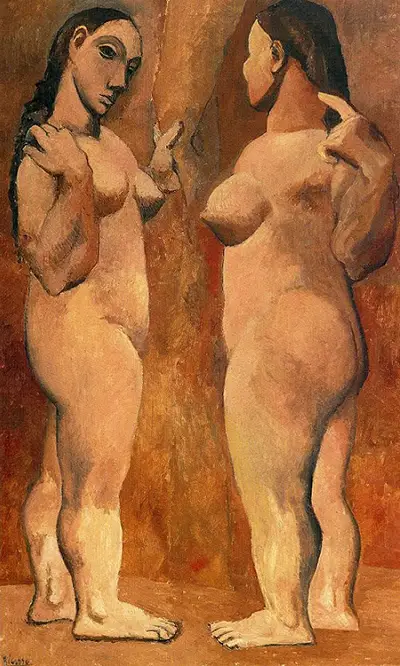The artwork is stored in Museum of Modern Art, New York and is depicted by massive monumentality and terracotta figure shades which are derived from the artist’s interest in his native Spain’s ancient Iberian sculpture of the time. Picasso, just like many artists in the first decades of the twentieth century, found non-western and ancient work more productive as compared to the imposed forms of industrial modernity's visual culture and academic paintings. The art of the two nude women appears almost like a mirror image while there is a strong resemblance in Les Demoiselles dAvignon's far left figure and the figure on the left. Similar to Demoiselles woman, with whom she resembles with her dark and hollow eyes and chiselled nose, this woman appears to be holding onto a curtain while gazing outside, in what seems to be a sign of beckoning outside viewers to join her in the room.
This gesture of the two nude women could be interpreted as prostitutes who are posing naked so as to entice men into joining them without necessarily uttering a word. The painting could also be interpreted as a general form of artwork without necessarily having a hidden meaning as Picasso would want the audience to view it. The naked woman holding the curtain could be considered as trying to signal a fellow woman to join them in the unseen stage or room. The other woman looks forward to the audience in a manner which could be interpreted as having additional women in the room or stage who are having a conversation.
Although Les Demoiselles d'Avignon's display of naked women is based on mythological, religious and naturalist paintings, Picasso's Two Nudes appears to be more closely related to Cezanne's monumental Bather paintings, ancient traditions of sculpturing-both archaic Greek sculpture and Iberian, and Aristide Maillol’s standing nudes which are squatly proportioned sculptures of 1861-1944. Picasso's use of monochrome creates a sense of the painting being sculptured from a real and rough substance, either stone or terracotta, which is similar several of his modern paintings and is a substitute to the carvings that he intended to make. In this painting, he had planned to collaborate with his friend and sculptor, Casanovas, although they did not coincide with this event.
Two Nudes is defined as one of the best modern arts by art theorist Maurice Cenis in his 1905 review of the Salon d'Automne. This definition is attributed to its attention to form, rather than anecdote and its synthetic character; primal in its reliance on artistic traditions rather than academic attributes, hence fresh and pure. Pablo Picasso has created many artworks which revolve around the subject of nudity such as Boy leading a horse, Blue Nude, Avignon, Seated Bather, Seated Nude, Nude in the black chair among others. The choice of this theme can be attributed to one of the most common painting methods of his time with various renowned artists like Francisco Goya, who painted the famous Naked Maja in 1797-1798. Picasso got most of his inspiration from his surrounding and the people around him rather than sticking to the set academic rules of painting. This technique has made his work stand out from many artists and sculptors who confined their thoughts and arts to a particular set of rules.

